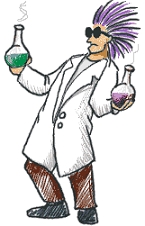| Quelques
élèments chimiques Hydrogen
is the lightest and the most common atom in the universe. Both
diamond and graphite are pure carbon, and so are the newly-discovered buckyballs. Nitrogen
is the major component of air. Oxygen
is the second most abundant element on earth (after silicon). Sodium
is one of the two elements in table salt (the other is chlorine). Aluminum
metal reacts with oxygen, but it forms an oxide coating protects it from further
reaction. Sulfur
is a yellow solid, and its chief industrial compound is sulfuric acid. Chlorine
is a green gas, but dissolved in water it is an effective disinfectant. Calcium
is a metal, and it is an essential component of bones and teeth. |  |
|
| |
| Carbon
is found in many different
compounds. Carbon
alone forms the familiar substances graphite
and diamond. Both are made only of carbon atoms.
There are strong covalent bonds between carbon atoms in each layer. But, only weak forces exist between layers. This allows layers of carbon to slide over each other in graphite. On the other hand, in diamond each carbon atom is the same distance to each of its neighboring carbon atoms. In this rigid network atoms cannot move. This explains why diamonds are so hard and have such a high melting point.
The 3-D coordinates for graphite and diamond are available in the MathMol Molecular Modeling Database. We urge you to download these structures to your home computer and use one of the suggested 3-D Molecular Modeling Software Packages. A third class of carbon compounds has recently been discovered. They are called fullerenes. The chime model shown below is one form composed of 60 carbons. Notice the geometric patterns of pentagons and hexagons that form the familiar icosohedron.
Compounds
made of Carbon The simplest organic compounds contain molecules composed of carbon and hydrogen. The compound methane contains one carbon bonded to four hydrogen's. Ethane is another example of a simple hydrocarbon. Ethane contains two carbon atoms and four hydrogen atoms. In chemistry we use a molecular formula to show how many atoms of each element are present in a molecule. A molecular formula however does not show the structure of the molecule. Scientists often use structural formulas to show the number and arrangement of atoms in a compounds. Below the molecular formula for methane and ethane are shown. Above the molecular formula are their respective structural formula.
Although structural formulas can be very helpful they do not give a complete picture of a molecule. Structural formulas do not tell us anything about the distances between bonds, the angles formed by these bonds, or the size and shape of the molecule. Scientists use four different representation to show what molecules look like. THE WIRE FRAME MODEL This model clearly shows the type of atoms in the molecule, the distances between bonds, and angles associated with the atoms. Because the lines drawn are very thin, molecules can very easily be manipulated when viewed on a computer screen. THE STICK MODEL Atoms and bonds are represented as sticks. THE BALL-AND-STICK MODEL Atoms are represented by balls and bonds are represented as sticks. THE SPACE FILLED MODEL This model shows the space that the molecule will take up. Because of all the points required to draw this molecule on a computer screen you should expect these molecules to be very difficult to manipulate.
|

